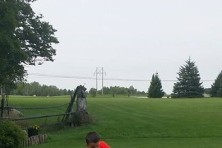Commentary: Life in Paradise, A Look at “Wayward Pines”
- Share
- Tweet
- Pin
- Share
We’ve heard this tale before. The setting might be a green valley in Vermont, the highlands of Scotland, or somewhere in the distant future. A traveler wanders in a remote countryside and unexpectedly comes upon a charming village – a delightful place to visit or even to settle permanently. But the visitor soon realizes that something strange and perhaps sinister is going on in this little paradise. He resolves to leave town at once – but is escape possible, and at what cost?
This story exists in numerous variations. It apparently began centuries ago as a European folk tale. During the 20th century it resurfaced as Thomas Tryon’s Harvest Home, James Hilton’s Lost Horizon, and Ira Levin’s The Stepford Wives. Broadway provided a more affirmative version in the Lerner and Loewe musical Brigadoon. The story was dramatized more than once on The Twilight Zone. One might refer to these works as “rural dystopia” or “country gothic.” But in the spring of 2015, the Fox television network carried this theme about as far as it can go in the 10-part series Wayward Pines. According to Internet sources, a second season of Wayward Pines is set to begin this spring.
It is impossible to summarize the plot of last year’s Wayward Pines, but perhaps the most interesting character was David Pilcher, who thought he had discovered proof that mankind is doomed to devolve into a race of mindless flesh-eating monsters. When no one paid attention to his pronouncements, Pilcher created Wayward Pines, a pristine village hidden away in the Idaho Rockies. In this beautiful place Pilcher would keep civilization alive.
The town of Wayward Pines was filled with well-dressed, well-housed, well-fed citizens. Its official motto was “Where Paradise is Home.” However, as is true of most utopias, no resident could ever leave. The village was surrounded by an electrified fence. And in order to make certain that no one stepped out of line, the villagers were occasionally summoned to public executions called “reckonings.” No one was safe because even a trivial or accidental offense could get someone “reckoned.”
Pilcher was a genius. He was also the most incompetent savior that a civilization could possibly have. The word “civilization” implies more than tidiness, and Wayward Pines had nothing that is characteristic of a vibrant civilization – no libraries, no art galleries, no music or local cuisine, and no sports, not so much as a ping-pong tournament. The villagers were enjoined, even commanded, to be happy and enjoy life, but they had little to enjoy and everything to fear. Such science as existed in Wayward Pines was geared not toward the discovery of knowledge but simply toward the preservation of Pilcher’s beloved Wayward Pines.
If Pilcher had been wiser, he would have created a place like Door County’s own Washington Island, which has a performing arts center, a community theater, an annual music festival, all kinds of water sports, camping, hiking, bird watching, and an impressive writers conference. It has places like the Red Cup Coffee House, where friends can gather to chat or catch up on the news. Washington Island might not be everyone’s idea of paradise, but at least Pilcher would not have needed public executions to keep his people in place.
For that matter, Pilcher might have taken lessons from Jens Jensen or from Door County itself, a place where one can still buy groceries in a general store, dine in a locally owned restaurant, stroll along woodland paths, take in an outdoor play or concert, and sleep in a country inn. In fact, for someone who has rarely ventured off of the interstate highways, driving into Door County may seem like entering another country and experiencing a new way of life. Door County has its problems, but it is home to many of the arts, the ideas, and the beauty that can make its residents look forward to every new day.
As for Wayward Pines itself, the new season is expected to begin on Wednesday, May 25. But let the viewer beware, unless he or she has a passion for country gothic. Otherwise, it might be more enjoyable for a Door County resident to go to the nearest village park and watch the sunset than to watch 10 new episodes of Wayward Pines.



